文章信息
- 顾重建, 金建钰, 上官福根, 毛李宁, 周化斌, 张永普
- GU Chongjian, JIN Jianyu, SHANGGUAN Fugen, MAO Lining, ZHOU Huabin, ZHANG Yongpu
- 温度驯化对红耳滑龟幼龟选择体温、热耐受性和抗氧化酶活性的影响
- Influence of temperature acclimation on selected body temperature, thermal tolerance, and antioxidant enzyme activity of juvenile red-eared slider turtles (Trachemys scripta elegans)
- 生态学报, 2016, 36(6): 1737-1745
- Acta Ecologica Sinica, 2016, 36(6): 1737-1745
- http://dx.doi.org/10.5846/stxb201408101597
-
文章历史
- 收稿日期: 2014-08-10
- 网络出版日期:2015-07-29
温度作为关键环境因素会影响爬行动物的生长发育、繁殖、生理、行为和后代表型等[1, 2, 3]。爬行动物在野外的体温变化与环境热源的可得性以及自身调温能力密切相关,它们可以通过行为调温,并辅以生理调温将其体温维持在相对适宜的水平[4, 5, 6]。过高或过低的体温对爬行动物有害甚至导致其死亡,相对较高的体温能使其行为和生理功能得到优化表达[7, 8, 9, 10]。即使在生存范围内,环境温度的变化也会改变变温动物的体温,从而改变生理和行为的表现,也可以通过温度驯化改变体温而产生影响[1, 4, 9]。温度驯化是生物适应温度变化的过程,会引起许多生理和行为特征的变化[9, 11],如喜好体温(Tp)、耐受高温(CTMax)、耐受低温(CTMin)和运动能力[12, 13, 14],以及代谢[15]和晒背行为[16]等。爬行动物的喜好温度通常用在实验室的温度梯度环境中测定的选择体温(Tsel)表示[17],热耐受性以在实验室通过测定最低(临界低温CTMin)和最高(临界高温CTMax)存活温度表示[18, 19, 20]。
温度驯化会影响变温动物的喜好温度和热耐受性[21, 22, 23],热驯化会增强大多数变温动物的高温耐受性,而冷驯化会增强低温耐受性[12, 13, 24]。温度驯化对动物适应性和运动能力的影响提出了有益驯化假说(Beneficial acclimation hypothesis,BAH),主要是通过变温动物对温度的驯化反应来验证,该假设认为特定温度驯化会增强动物个体在该温度下的生理表现和适应性[25]。有益驯化假设的许多验证实验对其普遍性持不同观点[26, 27, 28],提出了最适发育温度假设(OTH),适中温度比高温和低温下具有相对更高的适应性[26, 27];越热越好假设(WBH),在任何温度下,高温驯化的动物比中温或低温驯化的动物表现更好或适应性更高[26];越冷越好假设(CBH),低温下的个体比适中和高温的个体具有相对更好的适应性[26]。温度驯化对爬行动物生理和行为表现的影响,大多集中于陆生蜥蜴类[12, 13, 15, 20, 21, 22, 29];而水生龟鳖类也开展了一些相关研究,温度驯化会影响黄腹彩龟(Pseudemys scripta)的晒背行为[16],蛇鳄龟(Chelydra serpentina)的临界温度(CTM)与驯化温度相关[30],热驯化显著影响中华鳖(Pelodiscus sinensis)幼体的喜好温度和耐受性,其运动能力与“越热越好”假设一致[14]。
超氧化物歧化酶(SOD)和过氧化氢酶(CAT)是机体抗氧化清除自由基的主要酶类,组成了生物体内活性氧防御系统,其在清除超氧自由基、H2O2和过氧化物以及阻止或减少羟基自由基形成等方面起着重要作用[31, 32]。丙二醛(MDA)是氧自由基攻击生物膜中多不饱和脂肪酸(PUFA)造成脂质过氧而产生的过氧化物的终产物之一,能导致细胞和组织损伤,引起细胞代谢及功能障碍,甚至导致死亡。因此,MDA含量的高低可以间接反映机体细胞受自由基攻击的程度。驯化温度会影响荒漠沙蜥(Phrynocephalus przewalakii)肝脏的SOD活力[33],冷休克会提高虎纹蛙(Hoplobatrachus rugulosus)肝脏的SOD活性[34]。
红耳滑龟(Trachemys scripta elegans)原产于美国东南部和墨西哥东北部[35],属水栖龟类,为世界公认的生态杀手,已经被世界环境保护组织列为100多个最具破坏性的物种之一。近年来已在我国许多地区发现野外种群,严重威胁本土的生物多样性[36]。一些学者对红耳滑龟进行了热生物学研究[10, 37, 38, 39]。红耳滑龟幼体在具有温度梯度环境中的昼夜选择体温变化在26.6—30.4℃范围和CTMax为41.9℃[10],为了模拟野外气候可能发生的变化,设定了5个热驯化温度组(16、20、26、32℃和36℃),然后从生理生态角度探讨温度驯化是否对Tsel、CTMax、CTMin和TRR以及组织中的SOD活力、CAT活力和MDA含量产生影响?是否存在温度驯化效应?这对理解野外爬行动物对环境温度改变所产生的生理和行为上的适应性表现及保护当地物种具有非常重要的生态学意义。
1 材料与方法 1.1 材料实验用红耳滑龟(N=100)于2012年4月上旬购自温州市将军桥的花鸟市场,实验动物当天带回温州大学实验室。暂养3d后,选取健康个体90只,用Mettler 电子天平(±0.0001g)称量体重(BM)。测量后的个体随机单独放入标记好的500mL烧杯,烧杯底部加曝晒过的自来水,以淹过幼龟背甲为宜。
1.2 温度驯化驯化温度设为16、20、26、32℃和36℃ 5个梯度,每个温度梯度投放18只龟,将烧杯分别放置于预先设定的5个温度组的低温生化培养箱(BINDER KB400,±0.1℃,范围-10—100℃),每天换水并投放龟饲料,定期观察龟的健康状况,光照周期设为12L ∶ 12D,驯化时间为30d。各驯化温度中的12只幼龟用于选择体温和热耐受性测定,6只用于SOD活力、CAT活力和MDA含量测定。
1.3 选择体温和热耐受性测定Tsel测定在温度控制为18℃的房间内,在水深2.5cm(能完全淹没幼龟)的自制马口铁热梯度槽(长×宽×高=200cm×30cm×20cm)中进行评估。距离自制热梯度槽两端20cm处用铁丝滤网隔开,离槽底1.0 cm处的槽中部左右两侧各安装2 个具阀的出水孔,出水孔间隔20cm;在温梯度槽一端通入冰浴水,另一端通入水温65℃的水浴锅热水,使槽内形成10—55℃(±1.5℃)的温度梯度(图 1)。龟于8:00从低温端放入,于每天14:00测定,并在2h内结束。用UT-325电子点温计(±0.1℃)迅速插入幼龟泄殖腔1.5 cm处测定并记录泄殖腔温度(Cloacal temperature)。未进行喜好温度选择的个体不被用于统计分析。选择体温结束后,将龟重新置于相应驯化温度中恢复1d后进行热耐受性实验。
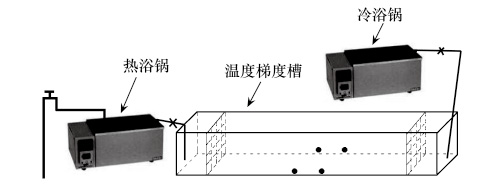
|
| 图1 热梯度槽示意图 Fig.1 The schematic diagram of thermal gradient groove |
CTMax和CTMin采用反正反应(righting response)方法确定[19, 21]。于10:00 — 16:00期间在BINDER培养箱中测定。从驯化温度0.3 ℃/min变冷或加热,当温度低于6℃或高于35℃后温度变化速率变得更慢(0.1℃/min)。先测定CTMin,重驯化1d后再进行CTMax测定。当幼龟在强烈刺激下不作出反应,如不能眨眼、翻身和爬动、四肢不能缩回时将其移出培养箱并迅速测出体温,实验结束3d内能够恢复正常活动的幼龟下限和上限体温数据被用于计算CTMin和CTMax。
1.4 SOD活力、CAT活力和MDA含量测定实验用红耳龟幼龟用断颈法处死,分别取骨骼肌、心肌和肝脏。用4℃下预冷的0.85%的生理盐水清洗血污,滤纸吸干,电子天平(±0.0001g)称取各组织质量,每2只龟的相同组织合并,各驯化温度为3组随机样。骨骼肌、心肌、肝脏分别稀释至5、10、5倍碾磨成匀浆离心取上清液于-60℃下保存。
按南京建成生物工程研究所生产的考马斯亮蓝试剂盒,超氧化物歧化酶(SOD)试剂盒,过氧化氢酶(CAT)试剂盒和丙二醛(MDA)试剂盒的说明书要求测定各组织蛋白质含量、SOD活力、CAT活力和MDA含量。
1.5 数据处理用Statisitca(Version 6.0 for PC) 统计软件包分析数据。用Kolmogorov-Smirnov 与Bartlett 分别检验数据的正态性与方差均质性。幼龟的形态参数、Tsel、CTMin、CTMax、TRR、SOD活力、CAT活力和MDA含量采用单因子方差分析(One-way ANOVA),多重比较均采用Tukey 检验。描述性统计值用平均值±标准误(范围) 表示,显著性水平设置为α=0.05。
2 结果 2.1 喜好温度和热耐受性不同驯化温度条件下幼龟的背甲长(F4,46=2.24,P =0.080),体重无显著差异(F4,46=1.82,P =0.141)(表 1)。
| 参数 Parameters | 16℃ | 20℃ | 26℃ | 32℃ | 36℃ |
| 样本数 Sample number (N)/只 | 10 | 9 | 10 | 11 | 11 |
| 背甲长Carapace length/mm | 64.9±0.8 (60.2—68.1) | 61.6±1.4 (54.4—66.8) | 62.1±0.9 (56.6—65.1) | 62.3±0.9 (58.8—68.6) | 63.6±0.5 (59.8—66.4) |
| 体重 Body mass/g | 44.3±1.3 (37.5—49.2) | 40.3±2.2 (30.7—49.0) | 40.0±1.8 (30.0—47.7) | 40.5±1.5 (34.3—51.8) | 44.1±1.3 (34.9—51.8) |
从图 2可知,在驯化温度16—36℃范围内,Tsel、CTMax和CTmin随驯化温度的升高而上升。单因素方差(ANOVA)分析显示,驯化温度极显著影响幼龟的Tsel(F4,46 =18.14,P< 0.0001),Tukey检验表明36℃与32℃无显著差异;16℃和20℃无显著差异。驯化温度极显著影响幼龟的CTmin(F4,46 =40.32,P< 0.0001),36℃和32℃显著高于26℃、20℃和16℃。驯化温度极显著影响幼龟的CTmax(F4,46 =71.30,P< 0.01),驯化温度越高,其差异越显著。驯化温度对TRR无显著影响(F4,46 =1.52,P =0.212)。
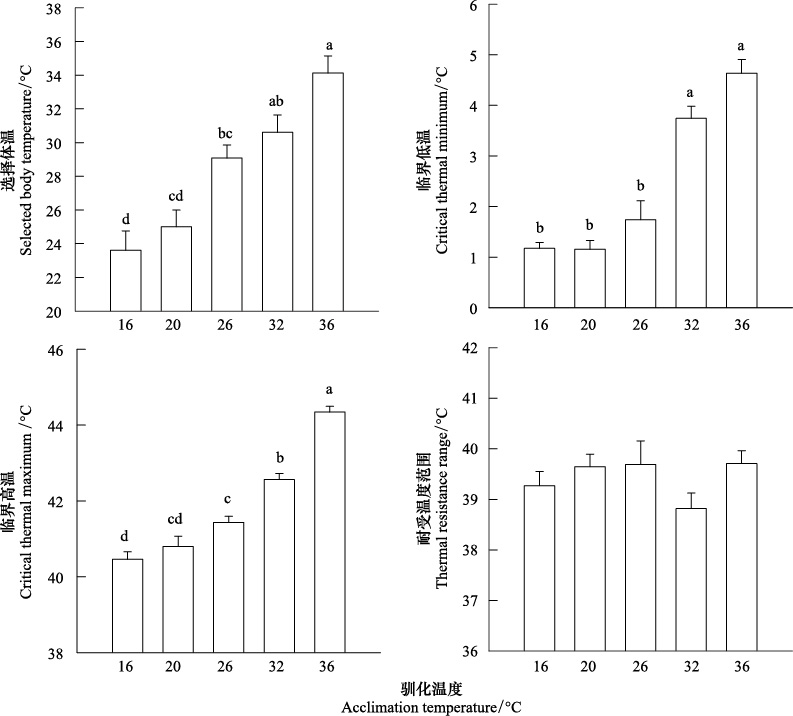
|
| 图2 驯化温度对红耳滑龟幼龟选择体温、临界低温、临界高温和耐受温度范围的影响 Fig.2 Effect of thermal acclimation on selected body temperature (Tsel) ,critical thermal minima (CTMin) ,critical thermal maxima (CTMax) ,thermal resistance range (TRR) of juvenile red-eared slider turtles,Trachemys scripta elegans |
由图 3可知,在16—36℃范围内,驯化温度显著影响骨骼肌(F4,10=6.55,P<0.01)和心肌(F4,10=5.07,P<0.05)的SOD活力,26℃驯化后的SOD活力显著高于16℃和20℃,但与32℃和36℃无显著差异。驯化温度显著影响肝脏的SOD活力(F4,10=18.63,P<0.001),32℃驯化后的SOD活力显著高于16℃和36℃,但与20℃和26℃无显著差异。
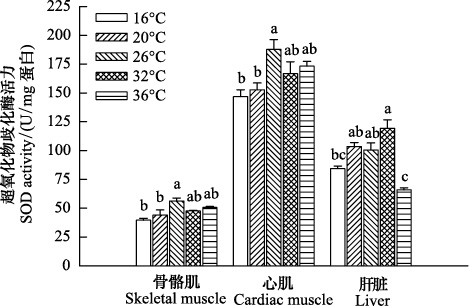
|
| 图3 驯化温度对红耳滑龟幼龟不同组织SOD活力的影响 Fig.3 Effect of thermal acclimation on SOD activity ofvarious tissues of juvenile red-eared slider turtles,Trachemys scripta elegans |
由图 4可知,在16—36℃范围内,驯化温度对骨骼肌CAT活力无显著影响(F4,10=0.80,P=0.55)。驯化温度显著影响心肌CAT活力(F4,10=3.99,P<0.05),36℃显著低于其它温度。驯化温度显著影响肝脏的CAT活力(F4,10=18.78,P<0.001),在驯化温度范围内,CAT呈现先下降后升高的趋势,16℃显著高于其它温度。
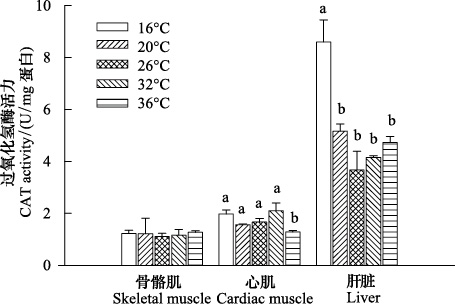
|
| 图4 驯化温度对红耳滑龟幼龟不同组织CAT活力的影响 Fig.4 Effect of thermal acclimation on CAT activity of various tissues of juvenile of red-eared slider turtles,Trachemys scripta elegans |
由图 5可知,在16—36℃范围内,驯化温度对骨骼肌(F4,10=1.83,P=0.200)和心肌(F4,10=2.20,P=0.142)的MDA含量无显著影响。驯化温度显著影响肝脏的MDA含量(F4,10=4.78,P<0.05),32℃驯化后的MDA含量显著高于16℃和36℃,但与20℃和26℃无显著差异。
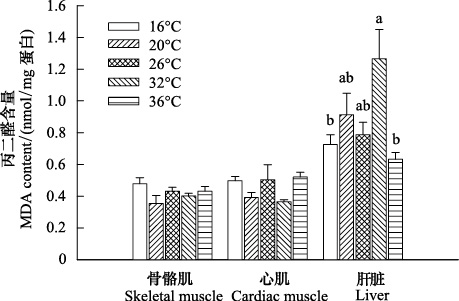
|
| 图5 驯化温度对红耳滑龟幼龟不同组织MDA含量的影响 Fig.5 Effect of thermal acclimation on MDA content of various tissues of juvenile of red-eared slider turtles,Trachemys scripta elegans |
爬行动物的热喜好(Thermal preference)和热耐受性(Thermal tolerance)会受到诸多因素的影响,如地理分布[19, 35],性别[40],环境温度[41],年龄[42],光周期[43, 44]等,而温度是其中最主要的影响因子之一,几乎影响了其所有的生理和行为活动。红耳滑龟幼龟在16—36℃的温度驯化范围,Tsel随驯化温度的升高而升高,但32℃和36℃的Tsel无显著差异,16℃和20℃组也无显著差异,这与红耳滑龟的生活习性有关,在驯化过程中发现相对较低温度驯化(16℃和20℃)极少进行活动和进食,相对较高温度驯化(32℃和36℃)的活动强烈且摄食能力强。当然随着驯化温度的升高,红耳滑龟的代谢加快和活动增多,这与代谢率和运动能力随着驯化温度升高而提高的结论相一致[12, 45]。爬行动物可通过行为和生理的调节,将体温维持在较高的水平,使生化和生理活动达到相对的最大值[4],使其自身能适应温度变高的周围环境,以达到喜好活动范围并随周围环境温度的升高而缩小,能够使栖息的位置处在一个比较稳定的范围内;也能通过适当提高体温,使其运动能力加大,以提升躲避天敌和捕食能力[10]。已有的研究表明,驯化温度对喜好温度的影响一般有3种模式,第1种模式为喜好温度随驯化温度的升高而往上漂移,如条纹南蜥(Mabuya striata)[23]、沙生黄蜥(Xantusia vigilis vigilis)[22]、北草蜥(Takydromus septentrionalis)[20],这与全球气候变暖导致变温动物体温调定点向上漂移的预测相似[9];第2种模式为高温驯化的喜好温度并非最高,而在适中温度驯化的喜好温度最高,如丽斑麻蜥(Eremias argus)、密点麻蜥(E. multiocellata)和山地麻蜥(E. brenchleyi)等3种麻蜥[12],贵南沙蜥(Phrynocephalus guinanensis)、青海沙蜥(P. vlangalii)和变色沙蜥(P. versicolor)等3种沙蜥[13],可能与温度调节的消耗与受益之间的权衡有关,在给定的环境条件中,体温调节能使爬行动物维持在最适范围的体温,使其生理活性达到最适水平,同时尽可能减少与温度调节有关的能量消耗[13, 46, 47],因此导致了高驯化温度下喜好温度不是最大化的结果;第3种模式为喜好温度随驯化温度升高而降低,如西方强棱蜥(Sceloporus occidentalis)[48]。研究认为,Tsel与驯化温度的设定有关,如中华鳖幼鳖经10、20℃和30℃温度驯化,其Tsel表现为20℃和30℃无显著差异,而显著高于10℃[14];15℃和25℃驯化的蛇鳄龟,其Tsel无显著影响[29]。 另外,喜好温度可能与栖息类型有关,红耳滑龟为水栖性龟类,水的热传导能力远大于空气,能快速被动获得热能,能量消耗较少,能获得更大的收益,因此,红耳龟幼龟的喜好体温符合越热越好假设(WBH)[27]。
红耳滑龟具有较大的耐温范围,是一种广温性动物[10]。红耳滑龟幼龟的热耐受上限(CTMax)和下限(CTMin)随驯化温度的升高而上升,低温驯化的个体比高温驯化的个体具有更强的低温耐受力,反之变然。这一现象广泛存在于变温动物中,如鱼类[49]、两栖类[41, 50]、爬行动物的有鳞类蜥蜴[12, 13, 22, 29]和蛇[51]和龟鳖类[14, 30]。在少数种类中,CTMax并非在最高温度驯化下达到最大,如丽斑麻蜥在33℃驯化的CTMax显著高于28℃和38℃[12],西方强棱蜥在25℃驯化下的CTMax高于15℃和35℃[21]。红耳滑龟在野外夏天温度较高时,具较强的高温耐受能力,低温耐受能力减弱,周围温暖的气候,使其不需花费更多的能量来增强低温耐受力,这与北草蜥相似[20]。
在16—36℃温度范围内耐受温度范围(TRR)并无显著差异,外温动物的TRR呈现多样性,例如北草蜥和中华鳖随着驯化温度的升高,TRR呈现先升高后下降的结果[14, 20];泽陆蛙(Fejervarya limnocharis)和饰纹姬蛙(Microhyla ornata)蝌蚪,丽斑麻蜥、密点麻蜥和山地麻蜥,贵南沙蜥、青海沙蜥和变色沙蜥的TRR随着驯化温度的升高呈降低趋势,28℃显著高于33℃和38℃[12, 13, 50]。红耳滑龟幼龟的TRR在各温度驯化组间无显著差异,说明不同种类TRR对驯化温度的响应有所不同。
3.2 温度驯化对不同组织抗氧化系统的影响驯化温度对红耳滑龟幼龟骨骼肌和心肌SOD活力的影响呈现相似规律,均以26℃最高,但26、32℃和36℃无显著差异,同时显著高于16℃和20℃;而肝脏以32℃最高,20、26℃和32℃无显著差异,但高于低温组(16℃)和高温组(36℃),说明不同组织细胞内的氧化胁迫程度有所不同,不同组织承受抗氧化胁迫的阈值可能也有所不同,肝脏作为排毒代谢的中心,其抗氧化损伤的能力强于肌肉组织。幼龟在36℃驯化下肝脏SOD活力明显下降,这与荒漠沙蜥不同,荒漠沙蜥在4、25℃和35℃条件下驯化15d,其肝脏组织中SOD活力随驯化温度的升高而增强[33]。水温会影响水生脊椎动物的抗氧化防御体系[52],一些慢性应激反应会引起氧自由基升高,机体可以通过提高抗氧化酶活力来清除氧自由基使机体适应环境[53]。爬行动物的代谢率和耗氧量随着环境温度的升高而增加[54],代谢速率加快会促进活性氧(ROS)的产生,从而对蛋白质、脂质和DNA等大分子物质产生氧化损伤,但ROS又会被SOD、CAT等抗氧化酶降解[55, 56]。在实验过程,发现36℃驯化组的幼龟部分个体肝脏变黑,36℃组SOD活力下降可能与持续过高温度对机体产生损伤有关。因为机体产生了大量的氧自由基,消耗了大量的SOD,而SOD表达供应来不及满足这一消耗,进而过剩的氧自由基可能又会对机体内蛋白质、核酸等进行攻击,导致细胞内氧化损伤加重,从而又导致酶活力下降。
驯化温度对幼龟骨骼肌CAT活力无显著影响,而影响心肌和肝脏。CAT活力水平在肝脏中明显高于心肌和骨骼肌,这与肝脏中存在大量过氧化氢类氧化物有一定的关系[57]。在肝脏中,CAT活力呈先降低后升高的趋势,这与尼罗罗非鱼(Oreochromis niloticus)幼鱼肠道CAT活力的表现一致[58],而中华鲟(Acipenser sinensis)血液CAT活力随温度的升高而增大[56],刘汝建等[59]对卵形鲳鲹(Trachinotus ovatus)肝抗氧化酶酶活力的影响发现,32℃组的CAT活力低于18—29℃组。肝脏的抗氧化防御系统为应对长时间低温驯化胁迫可能存在着一个机制,SOD和CAT在肝脏中出现了分工,通过此消彼长的方式来清除活性氧自由基等有害物质,这种形式也许为机体抵抗长期逆境胁迫所做出的最优选择。
驯化温度对幼龟骨骼肌和心肌的MDA含量无显著影响,而显著影响肝脏,说明不同组织MDA含量表达存在差异。肝脏MDA含量呈现先升高后降低的趋势,在16—32℃的驯化温度范围之间,MDA的含量随驯化温度的升高而升高,而在36℃的情况下,出现了骤降。中华鲟血清MDA含量随温度的升高而升高[56],褐牙鲆(Paralichthys olivaceus)幼鱼肝脏MDA含量在低盐状态下高温组明显较高[60],大连养殖刺参(Apostichopus japonicus)在温度骤减和缓减时体腔液的MDA含量均呈现出先升后减[61]。MDA含量水平的高低反映了细胞膜脂质的过氧化反应的程度,MDA含量的高低可以代表机体或组织的氧化水平高低[62]。随着温度升高,幼龟肝脏内的脂质过氧化反应得到加强,但过高温度抑制了脂质的过氧化反应。
CAT活力和MDA含量在骨骼肌和心肌中均低于肝脏,且骨骼肌中的CAT活力和MDA含量不受驯化温度的影响,心肌中的MDA含量也不受驯化温度的影响,说明肝脏CAT活力和MDA含量受驯化温度的影响更为敏感。在肝脏中,CAT在消除自由基的过程中,可能比SOD具有明显的作用。
综上所述,在一定的驯化温度范围内红耳滑龟幼体的Tsel、CTMin和CTMax均会随着驯化温度的升高而向上漂变,符合越热越好假说;同时,能通过抗氧化机制有效防御由于外界因素变化而引起的伤害,而超出这一范围后,机体将受到损伤。
| [1] | Huey R B, Stevenson R D. Integrating thermal physiology and ecology of ectotherms: a discussion of approaches.American Zoologist, 1979, 19(1): 357-366. |
| [2] | Lourdais O, Shine R, Bonnet X,Guillon M, Naulleau G. Climate affects embryonic development in a viviparous snake, Vipera aspis. Oikos, 2004, 104(3): 551-560. |
| [3] | Ji X, Gao J F, Han J. Phenotypic responses of hatchlings to constant versus fluctuating incubation temperatures in the multi-banded krait, Bungarus multicintus (Elapidae). Zoological Science, 2007, 24(4): 384-390. |
| [4] | Huey R B. Temperature, physiology, and the ecology of reptiles//Gans C, Pough F H, eds. Biology of the Reptilia. Vol. 12. New York: Academic Press, 1982: 25-91. |
| [5] | Castilla A M, Van Damme R, Bauwens D. Field body temperatures, mechanisms of thermoregulation and evolution of thermal characteristics in Lacertid lizards. Natura Croatica, 1999, 8(3): 253-274. |
| [6] | Winne C T, Keck M B. Daily activity patterns of whiptail lizards (Squamata: Teiidae: Aspidoscelis): a proximate response to environmental conditions or an endogenous rhythm? Functional Ecology, 2004, 18(3): 314-321. |
| [7] | Huey R B,Kingsolver J G. Evolution of thermal sensitivity of ectotherm performance. Trends in Ecology & Evolution, 1989, 4(5): 131-135. |
| [8] | Mondal S, Rai U. In vitro effect of temperature on phagocytic and cytotoxic activities of splenic phagocytes of the wall lizard,Hemidactylus flaviviridis. Comparative Biochemistry and Physiology Part A: Molecular and Integrative Physiology, 2001, 129(2/3): 391-398. |
| [9] | Angilletta M J Jr, Niewiarowski P H, Navas C A. The evolution of thermal physiology in ectotherms. Journal of Thermal Biology, 2002, 27(4): 249-268. |
| [10] | 张永普, 潘志崇, 计翔. 红耳滑龟幼体的热耐受性、体温和运动表现热依赖性. 生态学报, 2003, 23(6): 1048-1056. |
| [11] | Lagerspetz K Y H. What is thermal acclimation?.Journal of Thermal Biology, 2006, 31(4): 332-336. |
| [12] | Li H, Wang Z, Mei W B, Ji X. Temperature acclimation affects thermal preference and tolerance in three Eremias lizards (Lacertidae). Current Zoology, 2009, 55(4): 258-265. |
| [13] | Wang Z, Lu H L, Ma L, Ji X. Differences in thermal preference and tolerance among three Phrynocephalus lizards (Agamidae) with different body sizes and habitat use. Asian Herpetological Research, 2013, 4(3): 214-220. |
| [14] | Wu M X, Hu L J, Dang W,Lu H L, Du W G. Effect of thermal acclimation on thermal preference, resistance and locomotor performance of hatchling soft-shelled turtle. Current Zoology, 2013, 59(6): 718-724. |
| [15] | Rogowitz G L. Evaluation of thermal acclimation and altitudinal variation of metabolism in a Neotropical lizard, Anolis gundlachi. Copeia, 1996, 1996(3): 535-542. |
| [16] | Hammond K A, Spotila J R, Standora E A. Basking behavior of the turtle Pseudemys scripta: effects of digestive state, acclimation temperature, sex, and season. Physiological Zoology, 1988, 61(1): 69-77. |
| [17] | Licht P, Dawson W R, Shoemaker V H, Main A R. Observations on the thermal relations of western Australian lizards. Copeia, 1966, 1996(1): 97-110. |
| [18] | Lowe C H, Vance V J. Acclimation of the critical thermal maximum of the reptile Urosaurus ornatus. Science, 1955, 122(3158): 73-74. |
| [19] | Lutterschmidt W I, Hutchison V H. The critical thermal maximum: history and critique. Canadian Journal of Zoology, 1997, 75(10): 1561-1574. |
| [20] | Yang J, Sun Y Y, An H, Ji X. Northern grass lizards (Takydromus septentrionalis) from different populations do not differ in thermal preference and thermal tolerance when acclimated under identical thermal conditions. Journal of Comparative Physiology B, 2008, 178(3): 343-349. |
| [21] | Kour E L, Hutchison V H. Critical thermal tolerances and heating and cooling rates of lizards from diverse habitats. Copeia, 1970, 1970(2): 219-229. |
| [22] | Kaufmann J S, Bennett A F. The effect of temperature and thermal acclimation on locomotor performance in Xantusia vigilis, the desert night lizard. Physiological Zoology, 1989, 62(5): 1047-1058. |
| [23] | Patterson J W. Emergence, basking behaviour, mean selected temperature and critical thermal minimum in high and low altitude subspecies of the tropical lizard Mabuya striata. African Journal of Ecology, 1991, 29(4): 330-339. |
| [24] | Rajaguru S, Ramachandran S. Temperature tolerance of some estuarine fishes. Journal of Thermal Biology, 2001, 26(1): 41-45. |
| [25] | Leroi A M, Bennett A F, Lenski R E. Temperature acclimation and competitive fitness: an experimental test of the beneficial acclimation assumption. Proceedings of the National Academy of Sciences of the United States of America, 1994, 91(5): 1917-1921. |
| [26] | Huey R B, Berrigan D. Testing evolutionary hypotheses of acclimation//Johnston I A, Bennett A F, eds. Animals and Temperature: Phenotypic and Evolutionary Adaptation. Cambridge: Cambridge University Press, 1996: 205-237. |
| [27] | Huey R B, Berrigan D, Gilchrist G W,Herron J C. Testing the adaptive significance of acclimation: a strong inference approach. American Zoologist, 1999, 39(2): 323-336. |
| [28] | Wilson R S, Franklin C E. Testing the beneficial acclimation hypothesis. Trends inEcology and Evolution, 2002, 17(2): 66-70. |
| [29] | Huang S P, Hsu Y Y, Tu M C. Thermal tolerance and altitudinal distribution of two Sphenomorphus lizards in Taiwan. Journal of Thermal Biology, 2006, 31(5): 378-385. |
| [30] | Williamson L U, Spotila J R, Standora E A. Growth selected temperature and CTM of young snapping turtles,Chelydra serpentina. Journal of Thermal Biology, 1989, 14(1): 33-39. |
| [31] | 杜秀敏, 殷文璇, 张慧, 赵彦修. 超氧化物歧化酶(SOD)研究进展. 中国生物工程杂志, 2003, 23(1): 48-50, 74-74. |
| [32] | 张坤生, 田荟琳. 过氧化氢酶的功能及研究. 食品科技, 2007,(1): 8-10. |
| [33] | 陈卓, 安蓓, 李仁德. 温度对荒漠沙蜥肝脏组织中SOD活性的影响. 兰州大学学报: 自然科学版, 2004, 40(6): 83-85. |
| [34] | 王娜, 邵晨, 颉志刚, 凌云, 程东海. 低温胁迫下虎纹蛙的生存力及免疫和抗氧化能力. 生态学报, 2012, 32(11): 3538-3545. |
| [35] | Morin P J. Life history and ecology of the slider turtle. Science, 1990, 250(4984): 1164. |
| [36] | 史海涛, 龚世平, 梁伟, 洪美玲, 傅丽容, 汪继超. 控制外来物种红耳龟在中国野生环境蔓延的态势. 生物学通报, 2009, 44(4): 1-3. |
| [37] | Jackson D C, Palmer S E, Meadow W L. The effects of temperature and carbon dioxide breathing on ventilation and acid-base status of turtles. Respiration Physiology, 1974,20(2): 131-146. |
| [38] | Krivoruchko A, Storey K B. Regulation of the heat shock response under anoxia in the turtle,Trachemys scripta elegans. Journal of Comparative Physiology B, 2010, 180(3): 403-414. |
| [39] | Ligon D B, Peterson C C, Lovern M B. Acute and persistent effects of pre- and posthatching thermal environments on growth and metabolism in the red-eared slider turtle, Trachemys scripta elegans. Journal of Experimental Zoology, 2012, 317(4): 227-235. |
| [40] | Rock J, Andrews R M, Cree A. Effects of reproductive condition, season, and site on selected temperatures of a viviparous gecko. Physiological and Biochemical Zoology, 2000, 73(3): 344-355. |
| [41] | Sanabria E A, Quiroga L B, Martino A L. Seasonal changes in the thermal tolerances of the toad Rhinella arenarum (Bufonidae) in the Monte Desert of Argentina. Journal of Thermal Biology, 2012, 37(6): 409-412. |
| [42] | 邱清波, 曾小飚, 林隆慧, 计翔. 变色树蜥(Calotes versicolor)选择体温、热耐受性及温度对食物同化的影响. 生态学报, 2009, 29(4): 1738-1744. |
| [43] | Kosh R J, Hutcmson V H. Daily rhythmicity of temperature tolerance in eastern painted turtles,Chrysemys picta. Copeia, 1968, 1968(2): 244-246. |
| [44] | Graham T E, Hutchison V H. Effect of temperature and photoperiod acclimation on thermal preferences of selected freshwater turtles. Copeia, 1979, 1979(1): 165-169. |
| [45] | Zari T A. Seasonal acclimatization in metabolic rate of the fan-fingered gecko,Ptyodactylus hasselquistii (Reptilia: Gekkonidae). Journal of Thermal Biology, 1999, 24(2): 137-142. |
| [46] | Hertz P E, Huey R B, Stevenson R D. Evaluating temperature regulation by field-active ectotherms: the fallacy of the inappropriate question. The American Naturalist,1993, 142(5): 796-818. |
| [47] | Christian K A, Weavers B W. Thermoregulation of monitor lizards in Australia: an evaluation of methods in thermal biology. Ecological Monographs,1996, 66(2): 139-157. |
| [48] | Wilhoft D C, Anderson J D.Effect of acclimation on the preferred body temperature of the lizard, Sceloporus occidentalis. Science, 1960, 131(3400): 610-611. |
| [49] | Ford T, Beitinger T L. Temperature tolerance in the goldfish,Carassius auratus. Journal of Thermal Biology, 2005, 30(2): 147-152. |
| [50] | 施林强, 赵丽华, 马小浩, 马小梅. 泽陆蛙和饰纹姬蛙蝌蚪不同热驯化下选择体温和热耐受性. 生态学报, 2012, 32(2): 465-471. |
| [51] | Huang S M, Huang S P, Chen Y H, Tu M C. Thermal tolerance and altitudinal distribution of three Trimeresurus snakes (Viperidae: Crotalinae) in Taiwan. Zoological Studies, 2007, 46(5): 592-599. |
| [52] | Martinez-Álvarez R M, Morales A E, Sanz A. Antioxidant defenses in fish: Biotic and abiotic factors. Reviews in Fish Biology and Fisheries, 2005, 15(1/2): 75-88. |
| [53] | Demple B. Radical ideas: genetic responses to oxidative stress. Clinical and Experimental Pharmacology and Physiology, 1999, 26(1): 64-78. |
| [54] | 许雪峰, 计翔. 多疣壁虎静止代谢率的热依赖性研究. 杭州师范学院学报, 1998, (6): 53-58. |
| [55] | Sies H. Strategies of antioxidant defense. European Journal of Biochemistry, 1993, 215(2): 213-219. |
| [56] | 李大鹏, 刘松岩, 谢从新, 张学振. 水温对中华鲟血清活性氧含量及抗氧化防御系统的影响. 水生生物学报, 2008, 32(3): 327-332. |
| [57] | 刘冰, 梁婵娟. 生物过氧化氢酶研究进展. 中国农学通报, 2005, 21(5): 223-224, 232-232. |
| [58] | 王海贞, 王辉, 李瑞伟, 梁国栋. 温度和盐度对吉富罗非鱼幼鱼肠道两种抗氧化酶活力的联合效应. 广东海洋大学学院, 2012, 32(1): 47-53. |
| [59] | 刘汝建, 区又君, 李加儿, 苏慧, 曹守花, 王永翠. 盐度、温度对卵形鲳鲹选育群体肝抗氧化酶活力的影响. 动物学杂志, 2013, 48(3): 428-436. |
| [60] | 郭勤单, 王有基, 吕为群. 温度和盐度对褐牙鲆幼鱼渗透生理及抗氧化水平的影响. 水生生物学报, 2014, 38(1): 58-67. |
| [61] | 刘伟, 常亚青, 丁君. 温度缓降和骤降对刺参"水院1号"和大连养殖群体非特异性免疫影响的初步研究. 水产学报, 2013, 37(9): 1342-1348. |
| [62] | Viarengo A, Canesi L, Garcia Martinez P,Peters L D, Livingstone D R. Pro-oxidant processes and antioxidant defence systems in the tissues of the Antarctic scallop (Adamussium colbecki) compared with the Mediterranean scallop (Pecten jacobeus). Comparative Biochemistry and Physiology Part B: Biochemistry and Molecular Biology, 1995, 111(1): 119-126. |
 2016, Vol. 36
2016, Vol. 36




